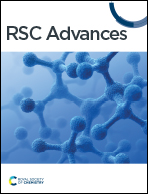Treatment of oil-based drilling cuttings by floatation-advanced oxidation two-step process
Abstract
In this paper, a floatation-advanced oxidation two-step process was proposed for deep oil removal of oil-based drilling cuttings (OBDC). In the first stage, a novel and simple degreasing solution was prepared and most of the base oil contained by OBDC was removed by flotation; in the second stage, the oil content of OBDC was further reduced by combined ultrasound + ozone (US + O3) advanced oxidation. The recommended degreasing solution was a mixture of methanol, ammonium chloride, and water with a mass ratio of 1.48.1 : 0.25. The best flotation process was as follows: a mass ratio of OBDC to degreasing solution of 1 : 10, stirring speed of 400 rpm and N2 flotation with a flow rate of 400 mL min−1 for 60 min. The oil content of OBDC can be reduced from 14.57% to 1.42% after flotation treatment and the degreasing solution can be reused more than five times. The optimal process of US + O3 advanced oxidation was as follows: a mass ratio of OBDC to water of 1 : 10, ultrasonic power of 1000 W, and an ozone flow rate of 4.0 L min−1 for 100 min. The oil content of OBDC can be reduced from 1.42% to 0.14% after US + O3 treatment at room temperature. The results of this paper provide a new method and idea for OBDC treatment.



 Please wait while we load your content...
Please wait while we load your content...